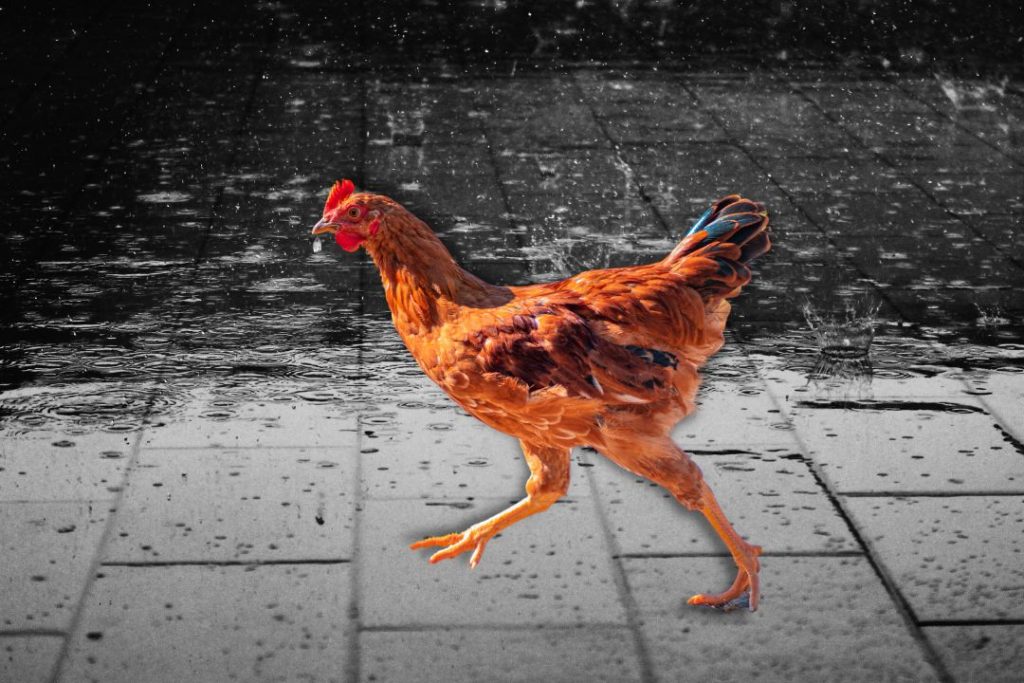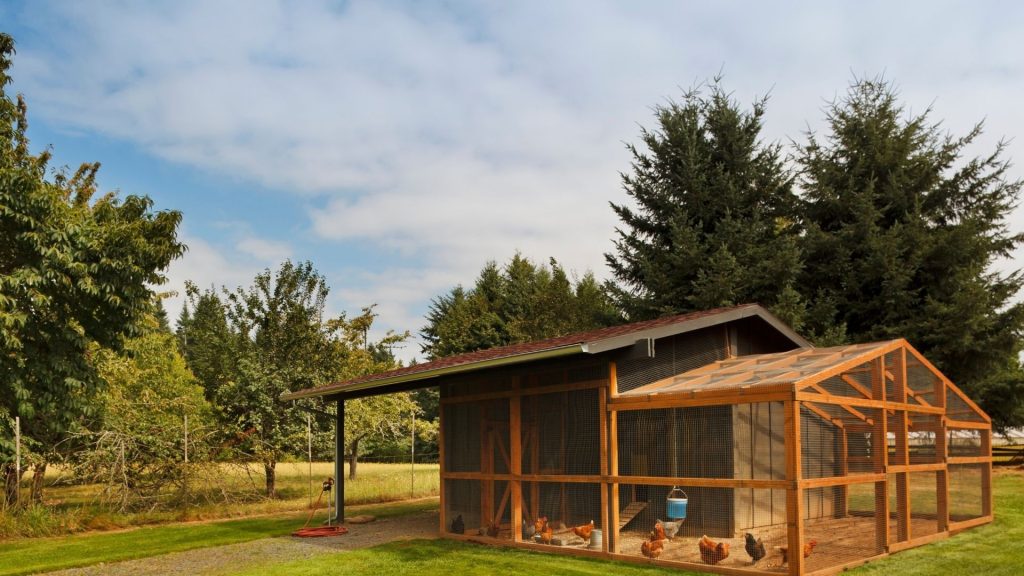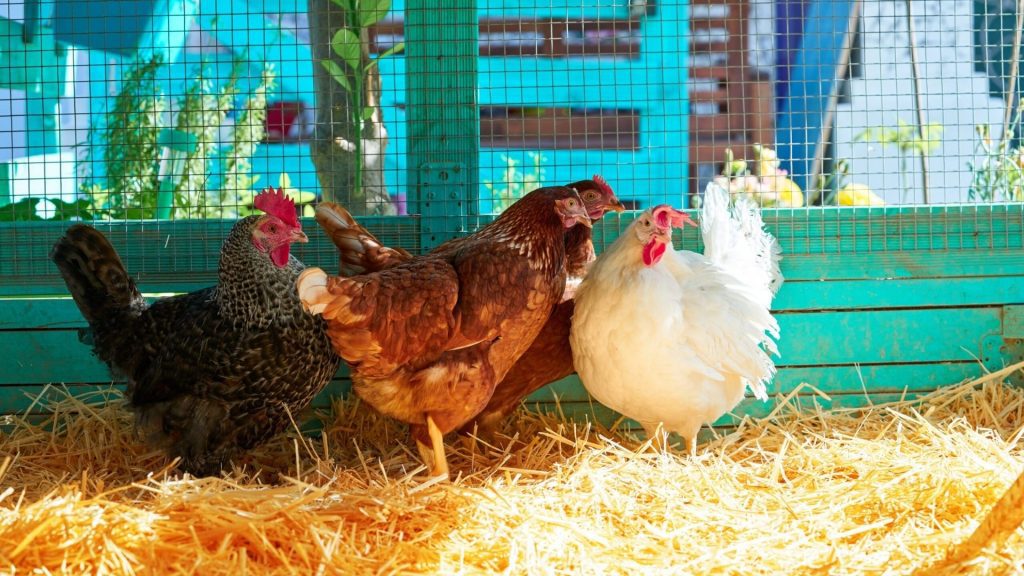Rainy days, with their tranquil showers and cool breezes, bring a refreshing change to the world around us. However, the rain also ushers in specific challenges when you’re a devoted chicken keeper.
Have you ever wondered how to keep chickens dry in the rain? In that case, you’re about to uncover a world of practical solutions that ensure your chickens remain comfortable and content, regardless of the weather.
As a caretaker of these lively creatures, your commitment goes beyond providing sustenance. It encompasses safeguarding their well-being during every season, including the rain-soaked ones.
This guide is your companion in understanding the intricacies of maintaining dry coops, preserving feather health, and creating rain-resistant outdoor havens.
We’ll explore strategies that cater to various aspects of rainy-day chicken care. From ingenious coop modifications to thoughtful feather maintenance techniques, each facet contributes to the overall comfort of your flock.
Whether you’re new to poultry keeping or an experienced hand, this guide will equip you with the insights needed to confidently embrace rainy days and ensure your chickens enjoy a dry and cozy abode.
How to Keep Chickens Dry in the Rain?
Chickens are hardy creatures but can become stressed and susceptible to health issues when exposed to prolonged rain. Wet feathers reduce their insulation, making them easier to cold temperatures. Dampness also invites parasites and bacterial growth, leading to potential diseases.
To know more about “how to keep chickens dry in the rain,” go through the details below:
1. Providing Adequate Shelter
In the symphony of rain, your chickens find their refuge. Cozy coops stand as resilient bulwarks against the elements. A roof that thwarts rain’s advances and diligent inspections ensures an impenetrable fortress.
Beddings, more than just comfort, absorb moisture and protect against dampness. Ventilation emerges as the unsung hero, orchestrating a dance between fresh air and rain resistance. And then there are the covered runs, a haven where outdoor joy remains untouched by rain.
These extensions of the coop or standalone retreats offer the perfect balance between exploration and protection. In this narrative, shelter is not merely a necessity; it’s a promise of warmth, dryness, and security amidst the raindrops.
2. Cozy Coops: A Rainy Retreat
As raindrops cascade from the sky, your chickens seek solace in their coop. The importance of a well-constructed and rain-resistant cage cannot be overstated. It is a fortress against inclement weather, ensuring that your feathered companions remain snug and dry within its confines.
The very foundation of this defense lies in the coop’s roof – a robust shield that stands resolute against rain’s attempts to infiltrate. Impermeability is the goal; not a single drop should get inside.
Regular inspections become your proactive weapon, allowing you to identify potential breaches, such as cracks or gaps that may grant access to rainwater. Swiftly sealing these openings prevents any unwelcome water intrusion.
Imagine, if you will, a cozy interior adorned with wood shavings or straw bedding. These elements are more than just comfort enhancers; they are steadfast allies against moisture. They absorb excess dampness, keeping the interior dry and conducive to your chickens’ well-being.
This meticulous attention to detail transforms the coop into a haven of warmth and protection, regardless of the rain’s persistence. Also it make your coop maintenance easier.
3. Ventilation Matters
While safeguarding against rain is pivotal, ensuring proper ventilation within the coop is equally essential. This delicate equilibrium between dryness and air circulation directly impacts your chickens’ health.
Stagnant moisture creates an environment conducive to respiratory problems and other health issues, making adequate airflow an imperative. Ventilation is your unsung hero in this narrative. The elevated coops with well-placed windows or ventilation slots offer a dual purpose – allowing fresh air to enter and circulate while preventing rain from invading.
This balance between air quality and rain protection is a testament to the thoughtfulness that goes into creating a harmonious living space for your chickens.
4. Covered Runs for Outdoor Play
The pitter-patter of raindrops need not mark an end to your chickens’ outdoor adventures. Chickens are natural explorers. Even the rain cannot deter them from venturing outside. This is where the concept of covered runs enters the stage – a haven that lets your chickens revel in the great outdoors without compromising their comfort.
These covered runs serve as extensions of their coop, providing a seamless transition from indoor to outdoor spaces. Alternatively, they can be standalone structures strategically placed in your backyard.
The key is to ensure ample space for your chickens to move around comfortably. These shelters offer protection from rain while allowing your flock to enjoy their surroundings without the inconvenience of wet feathers.
The covered runs epitomize the balance between freedom and shelter, ensuring that your chickens can continue their outdoor escapades even when the weather takes a turn for the wetter.
What Are The Tips For Rainy Day Chicken Management?
The rain might descend with its gloomy disposition, but armed with these ingenious management techniques, you can transform a potentially uncomfortable situation into one of care and comfort. Towel drying evolves into a gesture of safeguarding your chickens’ insulation and well-being.
A simple yet impactful bedtime routine ensures their night is free from damp discomfort. And in the heart of the coop, the deep litter method orchestrates a symphony of warmth and dryness. Rainy days may challenge you, but your proactive chicken care prevails.
After all, these techniques aren’t just about managing rain – they’re about nurturing a haven where your chickens thrive, rain or shine.
Towel Dry: Personal Chicken Care
Picture this scenario: a sudden downpour leaves your chickens drenched. But fret not, for your feathered companions deserve the same thoughtful care just as you’d attend to your beloved pet after a rainy walk.
Enter the humble yet effective tool – a clean towel. Gently and tenderly, patting your chickens dry becomes an act of love. This act, simple as it seems, holds significance beyond the surface. Rain-soaked feathers pose a risk beyond mere discomfort.
Feather insulation is a chicken’s shield against the elements, providing warmth and a critical barrier against the cold. Waterlogged feathers, however, compromise this vital insulation. Here, the towel becomes an ally in preserving the integrity of their plumage.
Bedtime Routine: Dry Before Dark
As the sun begins to set and night unfurls its velvety darkness, it’s time for a bedtime routine that transcends the ordinary. Chickens, like any creatures, seek comfort as they rest. But what happens when the rain has made an unwelcome appearance? Ensuring their dryness before they retire for the night becomes an integral part of your chicken care regimen.
Imagine this: a simple evening check, an inspection that holds the key to their nighttime solace. Damp feathers are identified, and a proactive solution emerges. Isolation is the strategy – providing a separate, dry space for those affected.
This separation prevents them from enduring the discomfort of a wet night and contributes to their overall well-being. Dryness, after all, is synonymous with warmth and comfort. So make sure your chicken bedding is dry and out of chicken water.
Deep Litter Method
Amidst chicken care techniques, the deep litter method stands as a champion of warmth and dryness. Think of it as a multi-layered haven designed to combat the challenges of rainy weather.
The concept is simple yet ingenious: layering bedding materials such as straw, wood shavings, and leaves on the coop floor. This layering isn’t just for show – it’s a strategic approach to maintaining a conducive environment for your chickens.
Delve deeper into the layers, and you’ll discover a remarkable synergy. A hidden heat source is generated as the litter breaks down over time. This natural process results in a cozy, temperature-regulated environment within the coop. But the benefits don’t stop at warmth alone.
The layers also play a pivotal role in moisture management. Rain’s attempts at infiltrating the coop are met with a potent absorber – the layered beddings. This absorption prevents dampness and helps maintain a dry and healthy living space for your chickens.
How To Build A Rain-Resistant Run?
As the rain arrives, your chickens deserve a rain-resistant haven that stands as a testament to your dedication to their well-being. Awnings and overhangs offer versatile protection, shielding against rain and providing respite from the sun. Clear plastic sheets innovate rain resistance, preserving visibility while warding off the wet.
Elevated platforms, strategic landscaping, and natural windbreaks elevate your chickens’ experience. Rain, once a challenge, is met with innovation. Rain-resistant runs become more than just shelter – they’re a testament to your commitment to your chickens’ comfort, come rain or shine.
Awnings and Overhangs
Imagine transforming your chickens’ outdoor haven into one that defies rain’s attempts to dampen their spirits. This transformation lies within awnings and overhangs – seemingly simple additions that can enhance your chickens’ living space.
Visualize the scenario: raindrops begin their descent, and your chickens seek shelter beneath the comforting cover of awnings and overhangs. What was once an open space now offers a refuge, a place where your feathered friends can revel in the outdoors while staying dry.
But the beauty of these structures extends beyond the rain’s domain. On days when the sun blazes, these awnings cast a gentle shade, ensuring your chickens are shielded from the sun’s intensity.
This dual-purpose design encapsulates the essence of intelligent outdoor space management – a space that adapts to various weather conditions, ensuring comfort and well-being for your flock.
Plastic Sheeting as Rain Shields
Now, let’s dive into innovation. Picture this: transparent plastic sheets adorning the sides of your chicken run. A fine yet formidable barrier emerges, shielding your chickens from rain and wind. However, the magic lies in its ability to maintain visibility.
Imagine your chickens nestled within, raindrops colliding with the plastic barrier while they stand unaffected. Their view of the outside world remains intact, fostering a connection with their surroundings even as they stay sheltered. It’s a brilliant strategy – rain protection without isolation.
Creating a Rain-Resistant Oasis
But the journey towards a rain-resistant haven doesn’t end here. Let’s explore further, unveiling more ingenious ways to craft an outdoor space that laughs in the face of rain.
Creating Elevated Platforms
Elevated platforms within the run introduce a new dimension of comfort. Not only do they provide a dry vantage point for your chickens to observe their domain, but they also contribute to the overall rain resistance of the area. Rainwater collects below, far from the high and dry roosts your chickens enjoy.
Strategic Landscaping
Think about the landscape as an ally in your quest for rain resistance. Gravel pathways become conduits that discourage water pooling.
The gentle slope of the terrain guides rain runoff away from your chickens’ favored areas, ensuring that their playground remains dry even after the rain has subsided.
Natural Windbreaks
Rain rarely travels alone – it often arrives hand in hand with the wind. Here’s where nature steps in as your ally. Shrubs, trees, and bushes thoughtfully placed around the run serve as natural windbreaks.
But their role doesn’t stop at wind mitigation; they also intercept rain, creating microenvironments of comfort within the run. When rain knocks on your chickens’ door, their rain-resistant run becomes a testament to your commitment.
Awnings and overhangs transcend simplicity, offering versatile protection against rain and relief from the sun. Clear plastic sheets introduce innovation, ensuring security without isolation. Elevated platforms, strategic landscaping, and natural windbreaks elevate the run’s functionality.
Rain resistance isn’t merely a defense; it’s a proactive stance, embracing the elements and transforming them into opportunities for comfort and well-being. Rain-resistant runs aren’t just structures; they manifest care, ensuring your chickens thrive regardless of the weather’s whims.
How To Maintain Your Chicken’s Health?
Rain or shine, healthy feathers aren’t just an aesthetic – they’re a testament to your commitment. You’re nurturing their armor with each nutrient-rich meal and designated dust bath area.
In the symphony of weather, your chickens stand resilient. Healthy feathers provide insulation, a refuge from temperature’s fickleness. They’re protectors, standing strong against rain’s attempts to dampen their spirits.
And amidst it all, the dust bath emerges as a timeless ritual. Beyond the surface, it’s a self-care ritual that celebrates feathers in all their glory. Healthy and happy chickens – an equation where rain’s challenge reminds you of your dedication to their well-being.
Healthy Feathers, Happy Chickens
Amid rain’s embrace, the vitality of healthy feathers gains prominence. More than adornments, these intricate structures serve as guardians against the elements. They embrace a role far beyond aesthetics – insulation, protection, and temperature regulation.
Consider the essence of feathers as nature’s armor. Rain may pour, but your chickens are fortified against discomfort with feathers in their prime. Insulation shields them from temperature fluctuations, ensuring they stay cozy even when rain whispers its chill.
Now, imagine a buffet of protein-rich delights. This isn’t just sustenance; it’s the foundation of thriving feathers. Nutrient-dense meals nurture the building blocks of feather health. It’s a symphony of health orchestrated from the inside out.
The Magic of Dust Baths
Now, let’s transition from nutrition to an age-old practice – the dust bath. Picture chickens reveling in this ritual, a performance of natural grooming. Dust baths? A masterclass in self-care.
Visualize a designated area within the coop adorned with sand or dry dirt. Here, your chickens immerse themselves, feathers wrapped in dust. It’s not just about cleanliness; it’s about removing excess oil, dirt, and unwelcome guests like parasites.
As the rain’s melody dances outside, your chickens indulge in a ritual that goes beyond the surface. Dust baths transcend the mundane; they’re a spa treatment, a grooming session that revitalizes feathers and fosters overall well-being.
What Are The Rain-Ready Tips for Beginners
Rain might challenge, but your novice journey doesn’t just embrace challenges – it conquers them. With breed selection, you’re aligning with nature’s design. Water-resistant feathers aren’t just features; they promise harmony in rain’s presence.
And in the arena of the run, mulching emerges as your strategy for cleanliness. Wood chips and straw transform the terrain into a dry haven. Mud and mess, once rain’s companions, find resistance at the coop’s threshold.
Rain-ready is your anthem as you take your first steps into chicken keeping. With water-resistant breeds and strategic mulching, rain becomes a challenge and a reminder of your preparedness. Your journey is poised for success, rain or shine.
Choosing the Right Breed
Embarking on the journey of chicken keeping in a region where rain is a frequent visitor demands strategic choices. As a novice, breed selection becomes your canvas for preparedness. Here’s where water-resistant feathers emerge as a trump card.
Imagine this scenario: rain’s gentle cascade, chickens navigating the wet terrain. But in their midst are breeds equipped for this very challenge. Orpingtons, Wyandottes, Sussex – these names aren’t merely labels. They’re synonymous with water-resistant feathers, nature’s armor against rain’s attempts.
So, for the beginner seeking harmony with rainy weather, breed choice is your compass. These breeds aren’t just chickens; they’re partners in your rain-ready journey.
Mulching the Run
Now, let’s navigate the realm of the run, the outdoor haven where your chickens frolic. Rain isn’t just water but a mud and muck catalyst. But here’s where the art of mulching enters, transforming this challenge into an opportunity for cleanliness.
Visualize wood chips or straw meticulously spread across the run’s terrain. A haven of relative dryness emerges where rain’s impact is minimized. But it doesn’t stop there. This mulching endeavor is a guardian of cleanliness. Mud’s attempts to infiltrate the coop are thwarted, ensuring the mess doesn’t migrate indoors.
Wrapping Up
Keeping chickens dry in the rain isn’t just about their comfort but their health and well-being. Providing a well-designed coop, covered outdoor spaces, and proper management techniques ensure that your feathered friends remain content even when the rain is pouring down.



